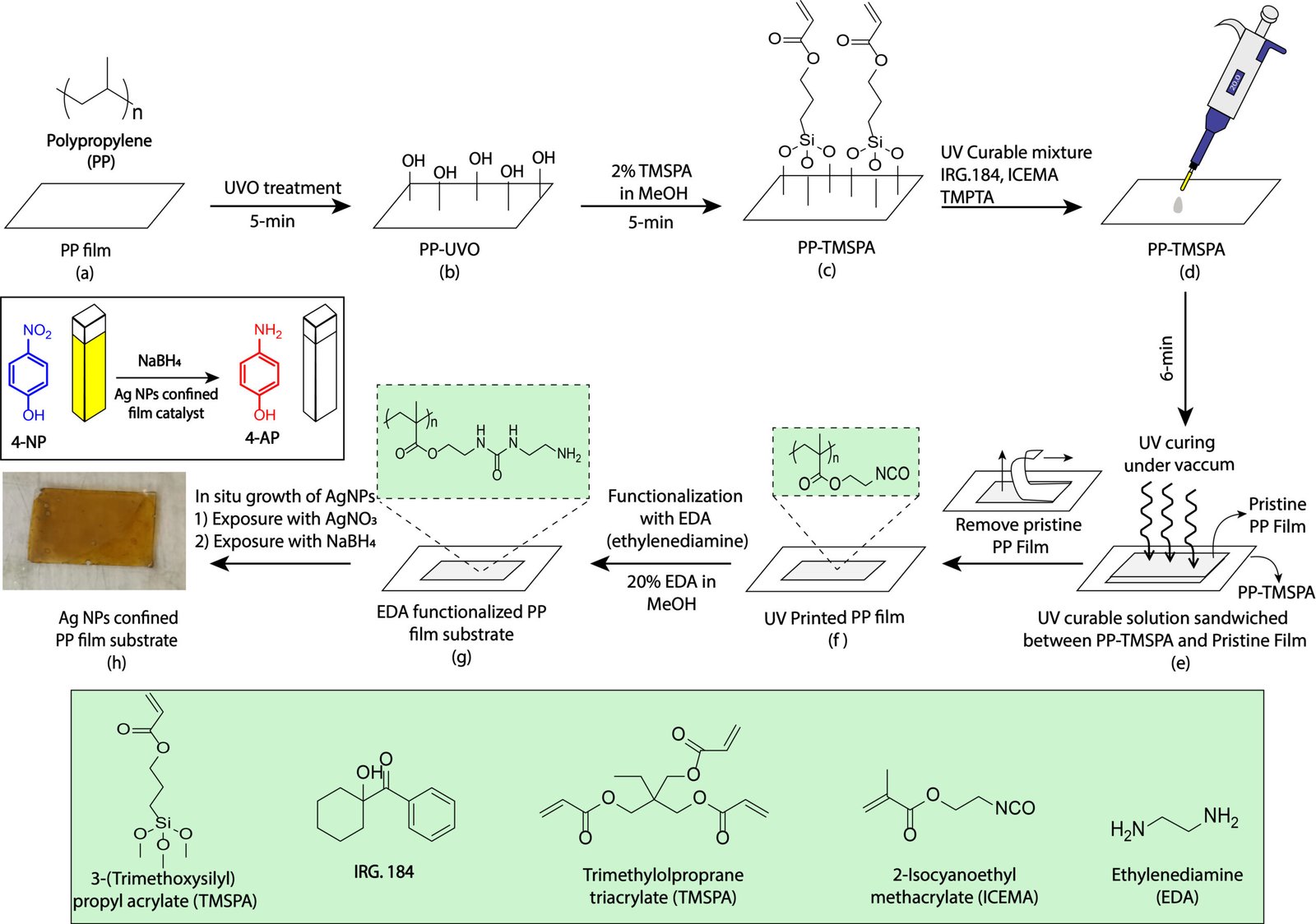Thin Films and Surface Chemistry
1. Size-Controlled Growth of Silver Nanoparticles on 3D-Printed Functionalized Polymer Films for Catalysis
Metal nanoparticles functionalized flexible films are of interest for a diverse range of applications. In this study, we present an amine-assisted strategy to achieve the surface-confined growth of silver (Ag) nanoparticles (NPs) on a widely used flexible polymer film surface, namely polypropylene (PP). The surface chemistry of PP film was tailored to incorporate specific chemical functionalities on its surface that could assist in the surface-confined growth of metal NPs. The PP film surface was modified by UV ozone treatment followed by silanization to functionalize the surface with acrylate groups. The acrylate-functionalized PP film was then functionalized with a UV-curable coating containing 2-isocyanatoethyl methacrylate (ICEMA) as the functional monomer to produce PP films with surface isocyanate (-NCO) groups. The reactive surface -NCO groups were subsequently employed to covalently immobilize ethylenediamine (EDA) on the surface. The PP film with surface amine groups was demonstrated as a suitable substrate to drive the confined growth of Ag NPs via an in situ approach. The Ag NPs growth process was fully optimized to achieve high surface coverage and uniform particle size distribution. Besides fully characterizing the surfaces, the efficacy of the surface-confined Ag NPs as thin-film catalysts was demonstrated by following the kinetics of the reduction of 4-nitrophenol to 4-aminophenol in the presence of sodium borohydride. The film with surface-confined Ag NPs was used in multiple catalytic cycles by simply recovering the film from the solution avoiding any complicated procedures for recovering and reutilizing the catalyst. This work contributes to the development of metal-functionalized flexible functional polymeric materials.

2. Carbohydrate Sensing with RB221 Dye on Optical Fibers
Carbohydrate recognition is central to many biological processes and has strong potential as a diagnostic marker, yet developing simple, cost-effective sensing platforms remains challenging. In our study, we used Reactive Blue 221 (RB221), a textile dye recently identified to have extraordinary affinity for carbohydrate molecules, as a synthetic receptor for carbohydrate detection. RB221 was immobilized on solid supports and its interactions with nine different carbohydrates were systematically studied, confirming strong and selective binding in aqueous environments. Building on this strategy, we extended the immobilization approach to functionalize tapered optical fibers with RB221. The resulting sensing platform, when integrated with phase shift–cavity ringdown spectroscopy (PS-CRDS), was demonstrated as a working optical sensor using glucose as a model analyte. The RB221-functionalized fibers exhibited high sensitivity and strong binding responses, validating the dye as a robust receptor for carbohydrate detection and paving the way toward the development of affordable, scalable, and portable diagnostic tools.
Publications
- Bakhatawar Malik, Ubaid Ullah, Iqra Azeem, Sana Nayab, Zakir H. Talpur, Rushba Saman, Hatice Duran, Shaper Mirza, Imran Cheema, Basit Yameen, “Expanding the toolbox of carbohydrate recognizing moieties: Demonstrating the interaction of carbohydrates with surface immobilized RB221 and translating it into a tapered optical fiber cavity ring-down sensor”, submitted.